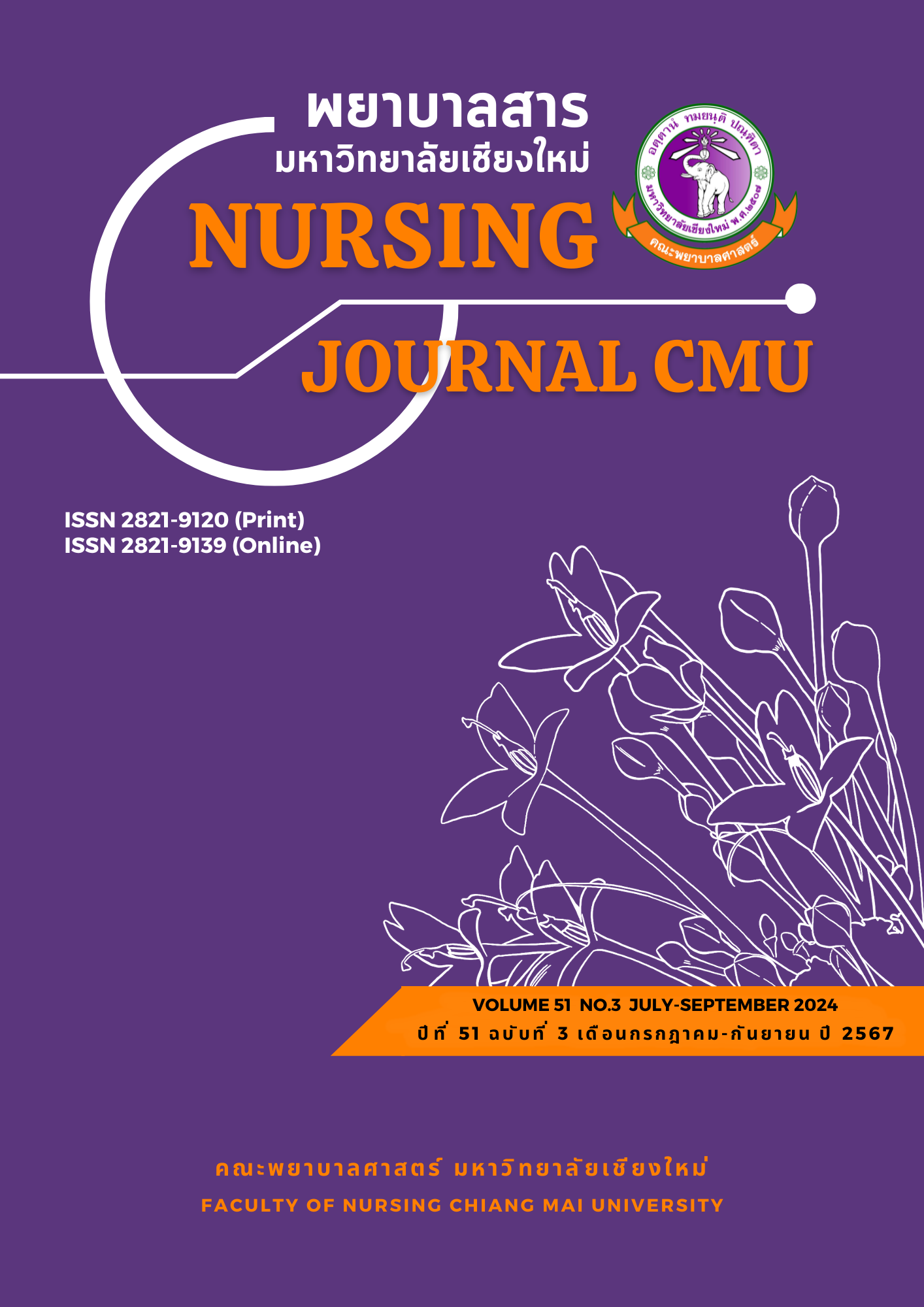Nursing Students' Satisfaction with the Use of Simulation Manikins for Venipuncture and Peripheral Intravenous Cannulation Practice in Networked Nursing Institutions
Keywords:
Satisfaction, Nursing students, Simulation manikin, Venipuncture, Peripheral intravenous cannulationAbstract
Venipuncture and peripheral intravenous cannulation practice are essential skills for nursing students. Practicing with highly realistic simulation manikins can enhance learning effectiveness and confidence before clinical practice in hospitals. This descriptive research aimed to examine nursing students' satisfaction with using simulation manikins for venipuncture and peripheral intravenous cannulation practice in networked nursing institutions. The participants consisted of 292 nursing students from the academic year 2023 in 10 networked nursing education institutions, selected through purposive sampling. The instruments used included a personal information questionnaire and a nursing student satisfaction assessment scale, which had a Cronbach's alpha coefficient of .97. Data were analyzed using descriptive statistics.
The research results showed that the highest levels of student satisfaction regarding usage were in the following three aspects: safety in usage (M = 4.61, SD = 0.65), the manikins meeting operational needs (M = 4.55, SD = 0.70), and ease of use without complexity (M = 4.49, SD = 0.72). The top three aspects of satisfaction with the design included the creativity in the manikins' creation (M = 4.64, SD = 0.64), the appropriateness of shape and size (M = 4.54, SD = 0.67), and the neatness and aesthetic of the manikins (M = 4.53, SD = 0.66).
This study concludes that nursing students are satisfied with using simulation manikins for venipuncture and peripheral intravenous cannulation practice, which can increase their confidence in their practical training and serve as a guideline for developing more effective simulation models.
References
Choeychom, S., & Rujiwattanakorn, D. (2015). The use of an innovative arm mode in practicing an intravenous infusion procedure of nursing students. Ramathibodi Nursing Journal, 21(3), 395-407. (in Thai)
Laha, W., Hiruntrakul, A., & Ninprapan, A. (2018). The satisfaction of user in the isometric leg strength dynamometer in sitting position for field test. KKU Research Journal (Graduate Study), 18(2), 32-43. (in Thai)
Ministry of Education. (1999). National education Act B.E. Siamsport Syndicate Public.
Mulyadi, M., Tonopa, S. I., Rompas, S. S. J., Wang, R. H., & Lee, B. O. (2021). Effects of simulation technology-based learning on nursing students’ learning outcomes: A systematic review and meta-analysis of experimental studies. Nurse Education Today, 107, 105127. https://doi.org/10.1016/j.nedt.2021.105127
Nantsupawat, A., Viseskul, N., Sawasdisingha, P., Auephawiriyakul, S., & Yimyam, S. (2022). The development of an intravenous injection arm model. Nursing Journal CMU, 49(3), 311-323. (in Thai)
Nontaput, T., & Chotiban, P. (2021). Intravenous venipuncture: New development in training on arm manikin. The Southern College Network Journal of Nursing and Public Health, 8(3), 49-60. (in Thai)
Phattarasatjatum, P., & Phromreugrit, K. (2018). The effectiveness of using backward design for developing learning outcomes according to Thai qualifications framework for higher education among nursing students. Journal of Nursing and Education, 11(3), 64-78. (in Thai)
Prakas, N., Sombutboon, J., & Khunwiset, S. (2019). Development of a simulation-base learning model for encouraging perceive self-efficacy in utilizing nursing process among nursing students at Phrapokklao Nursing College Chanthaburi. Nursing of Journal Phrapokklao Nursing College, 30(1), 200-215. (in Thai)
Thai Qualifications Framework for Higher Education. (2022). Office of the higher education commission. Royal Thai Government Gazette, 139(20), 28-31. https://www.ratchakitcha.soc.go.th/DATA/PDF/2565/A/020/T_0028.PDF
Thailand Nursing and Midwifery Council. (2021). Accreditation guide for professional education institution of nursing and midwifery (Rev.ed.). Golden Point.
Yamane, T. (1970). Elementary sampling theory. Prentice Hall.
Yanawongsa, T., Intasingh, S., Nguenyuang, S., & Intanet, N. (2021). Outcome-based curriculum: New approach for higher education curriculum. Humanities and Social Sciences Journal of Pibulsongkram Rajabhat University, 15(2), 279-291.
Downloads
Published
How to Cite
Issue
Section
License
Copyright (c) 2024 Nursing Journal CMU

This work is licensed under a Creative Commons Attribution-NonCommercial-NoDerivatives 4.0 International License.
บทความที่ได้รับการตีพิมพ์เป็นลิขสิทธิ์ของวารสารพยาบาลสาร
ข้อความที่ปรากฏในบทความแต่ละเรื่องในวารสารวิชาการเล่มนี้เป็นความคิดเห็นส่วนตัวของผู้เขียนแต่ละท่านไม่เกี่ยวข้องกับมหาวิทยาลัยเชียงใหม่ และคณาจารย์ท่านอื่นๆในมหาวิทยาลัยฯ แต่อย่างใด ความรับผิดชอบองค์ประกอบทั้งหมดของบทความแต่ละเรื่องเป็นของผู้เขียนแต่ละท่าน หากมีความผิดพลาดใด ๆ ผู้เขียนแต่ละท่านจะรับผิดชอบบทความของตนเองแต่ผู้เดียว






